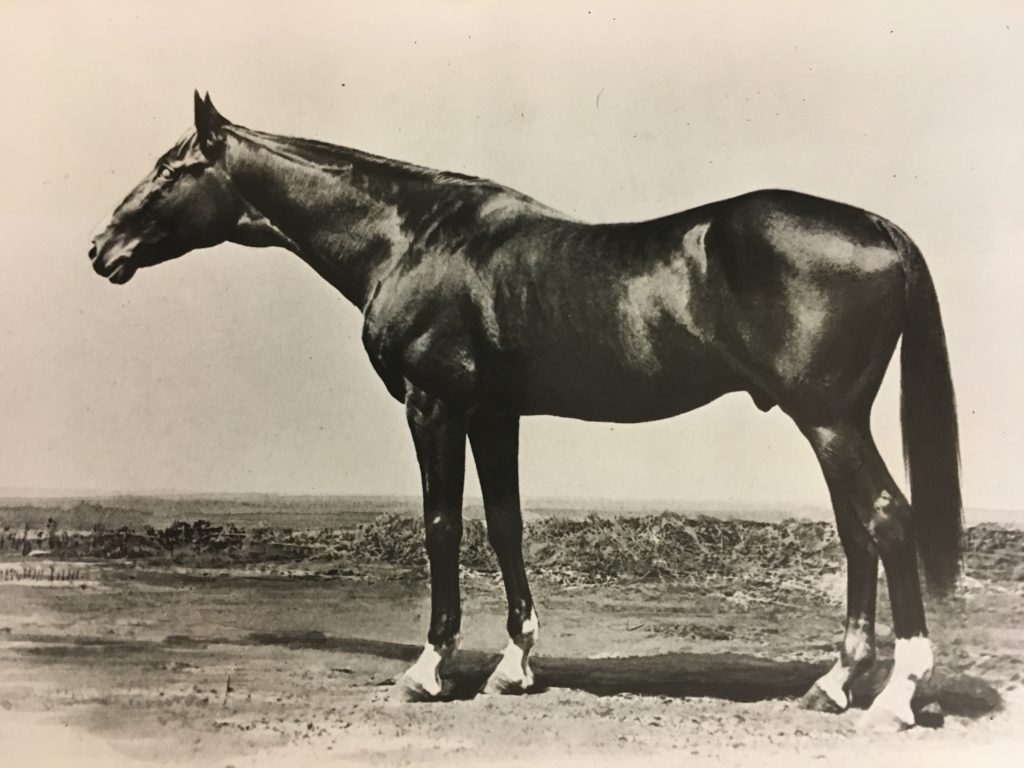
Lexington Photo: Courtesy of Keeneland Library Collection
By Peter Lee
When you think of great sires, stallions such as Mr. Prospector, Northern Dancer, Bold Ruler and Tapit. They’ve all made their mark on today’s breed. But who’s literally the granddaddy of all great stallions? That would be Lexington.
Lexington (1850-1875) was a horse in a long lineage of great horses. His sire was Hall of Fame champion Boston, who won 40 of 45 races, and his great-grandfather was the great sire Sir Archie. The blood of Eclipse ran through his veins as well, and you could trace his lineage back just a few generations to one of the founders of the breed, the Godolphin Arabian.
A bay horse, Lexington was relatively small, standing only 15.3 hands, but he was well conformed, with large shoulders and hindquarters. His only defect was a big head and poor vision, which he inherited from Boston. It caused him to be retired at the age of 5 after only racing seven times. Back then, races were run in heats, with the winner being the first horse to take two heats. Sometimes the horses would run four-mile heats, waiting for a winner to emerge.
Luckily Lexington never had to wait that long. On April 1, 1854, he won two consecutive heats, defeating his rival Lecomte. Lecomte exacted revenge one week later in the Great State Stake at Metairie Race Course in New Orleans. Richard Ten Broeck, head of the syndicate that owned Lexington, believed that the jockey made a Shoemaker-esque move at the end of the third mile, believing the race was over and easing Lexington up. Lecomte won the second and final four-mile heat in a then-world record time of 7:26, handing Lexington his only loss.
Lexington’s owners knew he could do better, and the next year, the horse ran in a race against the clock. Running again at Metairie, he rolled up a time of 7:19 3/4, blitzing Lecomte’s time by more than six seconds. He then beat Lecomte in a rubber match 12 days later in the Jockey Club Purse, winning the first heat in 7:23 ¾. Lecomte withdrew from the race after the first heat..
In his career, Lexington won six of seven starts, the lone loss being to Lecomte. He was retired to Midway, Kentucky but was sold to Robert A. Alexander for $15,000 in 1858, a record at the time. He stood for as much as $500 at Woodburn Stud at Spring Station, Kentucky — a high price at the time for stud duties.
Lexington was fierce as a stallion, but his progeny was a Who’s Who of American racing: Asteroid and Norfolk, both undefeated; Belmont stakes winners General Duke, Kingfisher, Duke of Magenta and Harry Bassett, a Hall of Fame inductee; and Hall of Famer Preakness, the namesake of the Preakness Stakes. He was the leading sire 16 times, a record that no one has even approached. (Bold Ruler and Glencoe led stallions eight times, the closest anyone has come.)
Had it not been for the Civil War, his progeny would have been even more outstanding, but he was still the leading sire during those years. During the war, Alexander, fearing capture by the Confederates, shipped Lexington and several of his more valuable horses north to Illinois.
Lexington went blind in his later years, caused by a facial infection, and was known as “the Blind Hero of Woodburn.” He was inducted into the National Museum of Racing and Hall of Fame as part of its inaugural class of 1955, along with his father, Boston, and great-grandfather, Sir Archie.
“His speed was so great that he could go within himself while other horses were running nearly their best rate and tiring, and for staying qualities which result from good wind, good disposition, sound legs, and easy action, he was unrivalled,” according to the book Famous American Race Horses.


